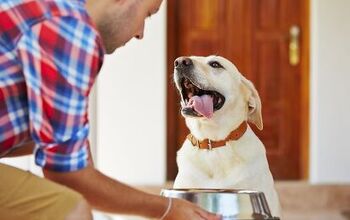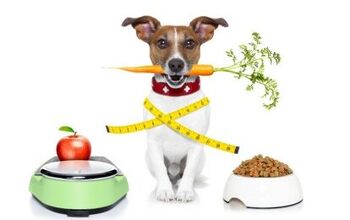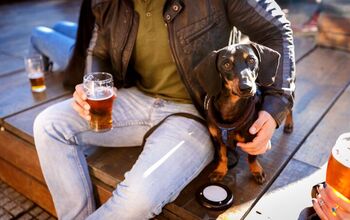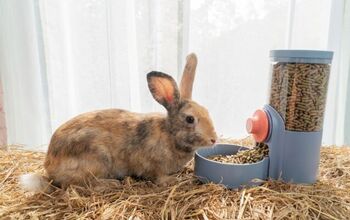Do I Have A Fat Dog? How To Tell If Your Dog Is Overweight

Dogs are known for being voracious eaters – no matter how well you feed them, they always seem to be hungry. This being the case, it is easy to slip your dog extra treats and snacks during the day. After all, a little snack now and then won’t do any harm… right? In reality, those little snacks quickly add up and before you know it, you’ve got a fat dog on your hands. While some people find chubby pooches cute, the fact is that weight gain can leave serious consequences on your pet’s health. There’s a thin line between well-filled and fat when it comes to canines, and it’s important to know if your pet just has some winter fluff to shed or is he at risk for developing severe health issues.
Just as you might use your BMI to determine the healthy weight range for your body based on weight and height, there are also ways to score a dog’s body weight Dogs are assessed on a scale from 1 to 9 with 1 being Very Thin, 5 being Ideal, and 9 being Obese. To determine your dog’s body score you will need to perform a set of simple checks as listed below:
- Feel your dog’s ribs: there may be a layer of fat over them but you should still be able to feel individual ribs. If your dog’s ribs are protruding, he is too thin – if you can’t feel them, he is overweight.
- Check the base of your dog’s tail: there should be a slight layer of fat so the area is smooth. If the bones protrude, your dog is too thin – if you can’t feel the bones, he is overweight.
- Feel for other bony protuberances such as the shoulders, hips and spine. If the bones protrude, your dog is too thin – if you can’t feel the bones, he is overweight.
- View your pet from above to assess his body shape: he should have a defined waist just behind the ribs. If the waist is very extreme, your dog is too thin – if there is no waist or if the area behind the ribs is wider than the hips, your dog is overweight.
- Look at your pet from the side to see if he has an abdominal tuck: the area behind his ribs should be smaller in diameter than the diameter of the chest. If the tuck is extreme, he may be too thin – if there is no tuck, the dog is overweight.
Obesity is a common and serious condition in dogs. The wrong lifestyle and diet can quickly lead to weight gain and if left unchecked, all those extra pounds could wreak havoc on your pet’s health. There are a number of diseases that have been linked directly to obesity in pets, and not to mention the fact that overweight dogs have a much lower quality of life than their slimmer fur friends. Here are some of the most common problems that are a direct result of canine obesity:
Heart and respiratory diseases
Having all that extra weight is a burden in both literal and metaphorical sense. Being obese will make it more difficult for your pet to breathe and make his heart work twice as hard. Even worse, if your pet has a preexisting condition or a propensity to develop one, such as collapsing trachea, excess weight is all but guaranteed to worsen his symptoms. Abdominal obesity has specifically been linked to cardiac disease in dogs, and being overweight has the power to cause structural and functional cardiac changes that could endanger your pet. Similarly, high blood pressure is a common problem for obese dogs.
Joint issues
It is estimated that as many as 25 percent of overweight dogs develop some type of serious joint complication. If your dog is overweight, his bones and joints have to work extra hard to support that weight which puts a great deal of strain on his body. It’s not uncommon for overweight dogs to develop arthritis or to have exacerbated symptoms to the additional pressure their weight is putting on their joints.
Diabetes
The more overweight your dog is, the more at-risk he is for developing diabetes – this condition is manageable but it has a major impact on your dog’s quality of life. Diabetes mellitus, if not treated properly and on time, can seriously threaten your pet’s health: vision loss, seizures, kidney failure, and ketoacidosis are just some of the potential outcomes. The first step to treating your pet for diabetes will be therapy and a lifestyle and diet change that would help him lose weight.
Digestive issues
Not surprisingly, it’s the poor diet that contributes most to obesity. Most dogs that are overweight have chronic digestive issues due to their inadequate meal plan and excess weight. Flatulence and excessive gas are a clear sign of these issues- although constipation or diarrhea are a common occurrence as well. To balance out your pet’s gastrointestinal tract while he’s working to lose weight, be sure to put him on a high-quality supplement that offers good fiber and probiotics. The fiber will help move things through the digestive tract and the probiotics will help replenish good bacteria in their gut and help ease their symptoms.
Tumors
Overweight dogs are at a higher risk for cancer- and it’s especially true for breeds already prone to it, such as retrievers. Benign fatty tumors, also known as lipomas, are commonly linked to obesity and it is believed by experts that up to a third of cancer cases in canines have been brought on by obesity.
Shorter lifespan
Not only that dogs that are obese have a diminished quality of life, but all those extra pounds can shorten their lives, as well. Studies have found that obese dogs live up to 2.5 years shorter than their healthy canine counterparts- a saddenning and sobering statistic for most pet owners. Not only that their pets are at risk for a range of serious health issues because of their obesity, but they are also more likely to die prematurely- a scenario no pet parent wants to go through.
If after performing this check you feel that your dog is overweight, your first step is to take him to the veterinarian. Your vet will perform an exam to see whether your dog’s weight has led to any other medical complications and he will help you to start your dog on a weight loss program. You may need to switch your dog to a Weight Control dog food formula and you will definitely need to monitor how much he eats. Encouraging your fat dog to engage in gentle exercises on a daily basis – something that won’t strain his bones or cause him difficulty breathing – will also help. Helping your dog to lose weight will take time but, as long as you are dedicated and consistent, it can be achieved.
It’s your responsibility to ensure that your fat dog maintains healthy body weight. It’s not terribly difficult to do, as long as you monitor your dog’s diet and activity, but it can make the difference between life and death for your pet.

Kate Barrington is the loving owner of two cats (Bagel and Munchkin) and a noisy herd of guinea pigs. Having grown up with golden retrievers, Kate has a great deal of experience with dogs but labels herself a lover of all pets. Having received a Bachelor's degree in English, Kate has combined her love for pets and her passion for writing to create her own freelance writing business, specializing in the pet niche.
More by Kate Barrington























